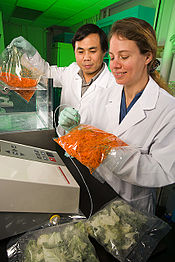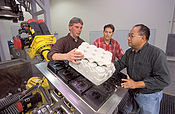



Packaging engineering, also package engineering, packaging technology and packaging science, is a broad topic ranging from design conceptualization to product placement. All steps along the manufacturing process, and more, must be taken into account in the design of the package for any given product. Package engineering is an interdisciplinary field integrating science, engineering, technology and management to protect and identify products for distribution, storage, sale, and use. It encompasses the process of design, evaluation, and production of packages. It is a system integral to the value chain that impacts product quality, user satisfaction, distribution efficiencies, and safety. Package engineering includes industry-specific aspects of industrial engineering, marketing, materials science, industrial design and logistics. Packaging engineers must interact with research and development, manufacturing, marketing, graphic design, regulatory, purchasing, planning and so on. The package must sell and protect the product, while maintaining an efficient, cost-effective process cycle.
Engineers develop packages from a wide variety of rigid and flexible materials. Some materials have scores or creases to allow controlled folding into package shapes (sometimes resembling origami). Packaging involves extrusion, thermoforming, molding and other processing technologies. Packages are often developed for high speed fabrication, filling, processing, and shipment. Packaging engineers use principles of structural analysis and thermal analysis in their evaluations.
Education
Some packaging engineers have backgrounds in other science, engineering, or design disciplines while some have college degrees specializing in this field.
Formal packaging programs might be listed as package engineering, packaging science, packaging technology, etc. BE, BS, MS, M.Tech and PhD programs are available. Students in a packaging program typically begin with generalized science, business, and engineering classes before progressing into industry-specific topics such as shelf life stability, corrugated box design, cushioning, engineering design, labeling regulations, project management, food safety, robotics, RFID tags, quality management, package testing, packaging machinery, tamper-evident methods, recycling, computer-aided design, etc.
AI
Artificial intelligence is becoming useful in several aspects of packaging development. Packaging engineers are using AI systems in their operations; AI can also design novel packages. For example, the DABUS system designed container for food and beverages with fractal patterns for gripping and for optical impact. Patent law is developing in this area. A World Patent has been issued with the inventor listed as DABUS but several jurisdictions indicate that a living person must be the inventor.
See also
- Packaging
- Packing problems
- Queueing theory
- Engineering economics
- Manufacturing engineering
- Cutting stock problem
- Bin packing problem
Notes
- Wood, Marcia (April 2002). "Leftover Straw Gets New Life". Agricultural Research.
- Johnson, C (1995). "In-House Testing of Computer Packaging". In Fiedler, R M (ed.). Distribution Packaging Technology. IoPP.
- Merali, Zeeya (17 June 2011), "Origami Engineer Flexes to Create Stronger, More Agile Materials", Science, 332 (6036): 1376–1377, Bibcode:2011Sci...332.1376M, doi:10.1126/science.332.6036.1376, PMID 21680824
- "Packaging Directory-Packaging Schools". Packaging world. 20 October 2011. Retrieved 14 Feb 2015.
- Lee, Ki-Eun; Kim, An; Lyu, Lee (November 1998). "Effectiveness of modified atmosphere packaging in preserving a prepared ready-to-eat food". Packaging Technology and Science. 21 (7): 417–423. doi:10.1002/pts.821.
- Braglia, Maracello; Frosolini, Montanari (January 2003). "Fuzzy logic controller in a packaging plant". Packaging Technology and Science. 16 (1): 21–35. doi:10.1002/pts.608.
- Hicks, A. J.; Medland, Mullineux (September 2001). "A constraint-based approach to the modelling and analysis of packaging machinery". Packaging Technology and Science. 14 (5): 183–225. doi:10.1002/pts.553.
- Johnston, R.G. (July 1997). "Effective Vulnerability Assessment of Tamper-Indicating Seals". Journal of Testing and Evaluation. 25 (4): 451–455. doi:10.1520/jte11883j. S2CID 111289045.
- Han, Jongkoo; Park (January 2007). "Finite element analysis of vent/hand hole designs for corrugated fibreboard boxes". Packaging Technology and Science. 20 (1): 39–47. doi:10.1002/pts.741.
- Zhang, Sheng (2022). "Research on energy-saving packaging design based on artificial intelligence". Energy Reports. 8 (7): 480–489. Retrieved 2 January 2025.
- Esfahanian, Shiva (2024). Implementing Artificial Intelligence in the Evaluation of Packaging Distribution and Label Design Modeling (PhD). Michigan State University. Retrieved 2 January 2024.
- World WO2020079499, Inventor The invention was autonomously generated by an artificial intelligence DABUS, "Food container and devices and methods for attracting enhanced attention", published 2020
- Sandys, A (21 December 2023), "UK Supreme Court has final say on Dabus as named inventor", JUVE PATENT
- "US patent office rules that artificial intelligence cannot be a legal inventor". www.theverge.com. 29 April 2020. Retrieved 26 August 2023.
Bibliography
- Yam, K. L., "Encyclopedia of Packaging Technology", John Wiley & Sons, 2009, ISBN 978-0-470-08704-6
- Hanlon, Kelsey, and Forcinio, "Handbook of Package Engineering", CRC Press, 1998